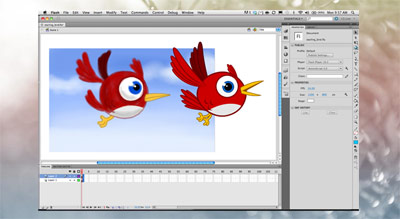Flipbook HTML5 because Flash is Dead, here is the Solution [new]
Looking to create a flipbook or convert PDF to a flip book? Flipbooks are made in both flipbook HTML5 and Flash, but if you are looking for an easy and simple web service for your online magazine, it`s not easy to find a perfect solution for your documents. I struggled for many years to find a smart platform for my content until YUMPU Publishing crossed my way. It’s absolutely free to sign up and in less than a minute my account was ready to publish at the Flipbook Creator YUMPU Publishing. Flipbooks exist as pretend books and flip magazines, a digital rendition of our favored hard copy material. It takes up less room than a PDF book page or other unwieldy text-heavy items and yet doesn’t skimp on the PDF content. Flipbooks that are created with HTML5 are cutting-edge, easier to customize, more accessible safer, and easy to use. But why? First, let’s talk a bit about what exactly Flash and HTML5 are before we dive into why a page-flipping flipbook in HTML5 will have the greatest impact on your business.
Table of contents
What is Flash?

If you used YouTube prior to 2015 you’ve witnessed Adobe’s Flash in action. Adobe developed Flash software as a multimedia platform used to incorporate animation, video, audio, and interactive features into everyday websites. Programmers use an object-oriented language called ActionScript to develop desktop applications, addicting mobile games like Angry Birds, and those annoying ads you see bouncing around in the sidebars of web pages. Google and Mozilla recently decided to disable Flash ads from running in their browsers – Chrome and Firefox respectively – much to the dismay of advertisement designers.
What is Flipbook HTML5?
HTML5 is a programming language whereas Flash is the product of using a computer programming language. HTML5 works hand in hand with cascading style sheets or CSS and flipbook jQuery, a Javascript library, to output beautiful and elegant objects similar to a free PDF flipbook online or a PDF page flip book. HTML has been around as long as markup language has existed, it used to be solely responsible to create websites and some small book page applications.
Things have progressed quite nicely for the original HTML and the fifth revision (HTML5) was introduced in 2011 as a more multimedia-friendly and easy version of itself. The release of HTML5 has effectively initiated the slow suffocation of Flash.
Now that you know the difference between the two contenders in PDF free flip book making we can answer who will be the winner-takes-all and why.
Mobile Users – Mobile Devices and Flipbook HTML5

In 2015 the number of mobile devices users browsing the internet surpassed the number of desktop users – by a considerable margin. We knew it would happen and now that it has it’s important we develop our content in a way so everyone can access it. Make a free flipbook with HTML5 to accomplish this very well as they are built to be responsive to any screen size on any mobile device.
Contrarily, Flash is incompatible with iOS-run products (think iPad and iPhone) which limits the functionality of a page-turning flash flipbook magazine altogether. If you’re going to spend a lot of time and effort creating killer content you probably want to ensure that you aren’t thwarting any potential viewers. So what’s the answer? Build an HTML5-based flipbook magazine instead which is compatible with mobile devices. Another important aspect is social media and the possibility to share your flip magazine on Facebook, Twitter, or any other network.
Interactive Features
Arguably, the most important element of a flipbook magazine is the fact that it is highly interactive and allows the reader to control the depth at which they consume the PDF files to flip book pages’ content. Free Flipbooks often include video, background music to pull on your heartstrings, shareable content, and blazing call-to-action buttons that help make the audience feel included as they soak up your material.
All of these features and information are rendered right on the webpage affording it speed and flexibility. Unfortunately, a flash flipbook will lack this flexibility and will demand a lot of your CPU bringing everything you’re doing to a snail’s pace.
Security

Listen up, because this is a big one. Using Flash poses a serious threat to the safety of your computer – and your information.
It seems like once a week Adobe is rolling out “emergency” security patches to try and keep relentless hackers from finding a way to exploit you.
Sometimes, the only option you have is to uninstall the player to prevent your computer from being damaged beyond repair. Without the flash player installed we again see how detrimental Flash can be to your content marketing strategy.
Flash security flaws can lead your PC to crash or – more alarmingly – allow a hacker to take complete control of your digital environment. If for no other reason, choose to design and publish an HTML5 flipbook to prevent your audience from having to choose between their security and you.
SEO

It all comes down to semantics, and semantics is something that Flash does not play well with. Imagine you are a Google spider crawling your way through cyberspace and reporting back to Google Search all of the details of every web page on every website – ever. If you stumbled across a page laced with Flash software it would be like hugging a big box trying to absorb the content within. It won’t work.
When you create a PDF to page flipping book or flipbook with flash the container in which your flip book pages are essentially the aforementioned big box and the content (what we want everyone to see) is the stuff hiding inside. Through SEO you are crafting the code and content to fit the likes of major search engines like Google and Bing. HTML5 gets it. HTML5 flip will deliver the important data – like keywords – from your flipbook with a page flip effect to the search sites in order to help others find you.
Flash is Dead – The solution is simple and free!

The Flipbook Creator YUMPU Publishing is the easiest website to use. I would suggest the software to anybody interested in promoting flipbooks, magazines, PDF files, or e-books. It’s simple, fun, and free. Best of all, it supports a variety of mobile and desktop devices, generates search engine optimization terms, and can be embedded in social media sites. Sign up for a free account today and start your personal experience.
If you’ve been blogging for any period of time, you’ll know that creating a lead magnet is the best way to build your email list. But standing out beyond the usual checklists and guides isn’t easy. Everyone and their mother has written a PDF five-point how-to guide or cheat sheet and put it on their website. I knew I had to compete, but I wasn’t sure how to do it.
The Problem: Boring PDF Lead Magnet
At first, I thought I would try changing up the content. I made the content longer at first. And then shorter. Either way, I didn’t get the impression from my readers that they ever looked at my PDF lead magnet past the first view and definitely didn’t share it with anyone else. I knew there had to be a better way to make my lead magnet stand out than turning it into some big video sales letter or making my content longer. A blogger friend of mine suggested I turn it into a flipbook html5; she’d seen it work for her site and thought that it might work for my audience, too.
So I researched it. What was a flipbook, anyway? Turns out, I’d seen flipbooks before… at least the physical kind. Do you remember those small books whose pages you’d “flip” and create animation? Well, a flipbook html5 is a call back to those old books. What it does is virtualize the act of “flipping” through a magazine and transform an otherwise 2D pdf into a 3D experience. In turn, the perceived value of the PDF will increase in the eyes of the prospect.
The Solution: An HMTL5 Flipbook
So I thought that I’d try to make one of these html5 flipbooks. But how do I do it? Upon further research, I discovered that there are a handful of companies that will help you make one yourself:
Issuu.com
Yumpu.com
flippingbook.com
3dz.com
publitas.com
My Desired Features
For me, the most important features of a flipbook service had to have been ones that made it easier for me to create it quicker and easier for my readers to share it with others.
Pricing– it has to be affordable for a blogger like me
Supports all devices, including mobile and desktop– mobile traffic is dominating right now
Optimized for search engines like Google– I wanted something that Google actually recognizes
Use my own branding– it’s not going to do me any good if I can’t brand it
Embed it on a variety of platforms– for example, upload it to my Facebook page
Fully integrated with all major social networks– easy sharing is important for traffic
Embed Video and Audio into publications– the best content uses multiple mediums
Link to external links from my flipbook– affiliate links? Further reading? My purchase page? Linking needs to be easy
Before I was going to spend too much time on this, I figured I’d compare each one. Here are five I found online that offer flip book html5 services.
Issuu.com
Issuu is a company that caters to magazine publishers. They offer three product tiers: Basic (free), Premium ($35/month), and Optimum ($269/month). At the Basic level, you get an embedded reader that is mobile Friendly, has in-document Search, has no restrictions on traffic, is sharable by social media, is SEO-friendly, converts from a PDF, can include video, and has a full-screen reading mode. You also get a month of statistics. Each plan is billed annually, rather than monthly.
YUMPU Publishing
Simply browse through various publications, select a topic and read your magazine online.
YUMPU Publishing is a company that caters more to all publications, rather than focusing on magazines. This publishing software has five plans: FREE, adFREE ($19.95/month – billed annually), Webkiosk ($95/month + one-off fee of $119 for setting up the WEBKiosk), APPKiosk ($219/month), PROKiosk ($399/month). With the FREE plan, you get an unlimited amount of magazines, unlimited pages per magazine, and HTML5, Flash, and JS magazines. The Adfree program offers Google analytics, privacy settings, and no external ads. Plans are billed monthly (and yearly), which makes it easier to afford than the other annual-only plans of the other providers.
Using This Publishing Software
Using the site was pretty easy. After I signed up I clicked the “Create a Magazine” link in the navigation menu, which took me to an easy drag-and-drop screen where I could drag my PDF.
I uploaded the file, which took less than two minutes. I was then prompted to confirm some of the magazine details, such as the name, category, and visibility.
Once uploaded, I was able to change even more features at will, including ad and sharing settings. I could even upload a new version of the magazine or delete it from a single dashboard.
flippingbook.com
Flippingbook is a flipbook HTML5 company that offers two ways to build PDF to flipbook magazines yourself: either use the desktop program or build one online. The online version has one-click uploads, branding options, lets you embed it in any website, and SEO options. The online plan is $49 per month billed annually.
3dz.com
A friend in Europe mentioned 3DZ to me, so I visited. The site was in German, so I had to use google translate. 3DZ offers three publication options: HTML5, ePaper, or mobile application. They don’t offer signups on the site, so I figured that this was more of an enterprise option and skipped further research.
publitas.com
Publitas is another option I found for flipbook HTML5 creation from a PDF. They were geared more toward those wanting to publish a digital catalog. Based on what I saw, their offering could work for anyone thought. Their service has built-in navigation, mobile-friendly design, touch-responsive buttons, page overviews, links, PDF downloads, social sharing, video embeds, and the “flip page effect”. They offer five tiers: Free, Bronze ($10/month), Silver ($29/month), Gold ($99/month), and Enterprise (unknown pricing). Publitas also offers yearly pricing with a slight discount.
After research, I decided to go with this publishing software. They were the most affordable and versatile for what I was looking for and had options to scale up, which is something I might want to do in the future. So I went with their Free Plan, which already offers a great ton of features. And since I don’t plan on adding a shopping cart or product pages to my PDF, I decided that Publitas wasn’t quite the right fit.
Conclusion
If you want your lead magnet or ebook to stand out, then you need to do what others aren’t willing to do. And right now, that’s taking the extra step and converting it into a digital PDF to flipbook. There are many options out there, so there is sure to be a product that fits your budget and functionality requirements. For myself, I found out that the software offers the best solution for publishers and for readers. Do not waste any time and start today with your first outstanding flipbook at YUMPU Publishing!

 Hey,
Hey,